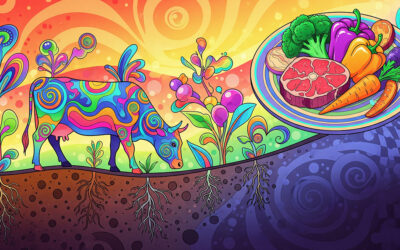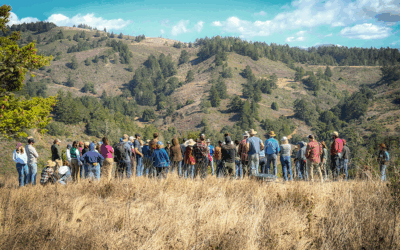Why We Care
We have the opportunity to adopt a form of agriculture that produces not just food, but also a wide range of social, economic, nutritional, ecological, and climate benefits. Regenerative agriculture improves soil health and sequesters carbon, improves water quality and holding capacity, supports biodiversity, increases the nutrient density and long-term resilience of our food supply, and improves the prosperity of rural communities.
Photo Credit: William Milliot
We have the opportunity to adopt a form of agriculture that produces not just food, but also a wide range of social, ecologic, climate, nutritional, and economic benefits. Regenerative agriculture improves soil health and sequesters carbon, improves water quality and holding capacity, supports biodiversity, increases the nutrient density and long-term resilience of our food supply, and improves the prosperity of rural communities.
Regenerative agriculture is one of the most promising solutions to many of the problems we face today.
Climate
For hundreds of thousands of years a unique climate has supported flourishing human and natural life. Earth is the only planet known that can support humans, but only if we keep the concentration of carbon dioxide in the atmosphere to less than 350 parts per million. As the Dalai Lama tweeted in 2016, “This planet is our only home; we are all responsible for taking care of it.”
Because “no other mechanism known to humankind is as effective in addressing global warming as capturing carbon dioxide from the air through photosynthesis,” the team of Drawdown ranked Regenerative Agriculture 11th of 100 solutions to draw down carbon from the atmosphere. According to their calculations, Regenerative Agriculture could result in a reduction of 23.15 gigatons of carbon dioxide, from both sequestration and reduced emissions, by 2050.
Water
Seventy-one percent of Earth’s surface is covered by water, with 96.5 percent of all water held by the oceans. The presence and abundance of water distinguishes Earth from other planets, and we are utterly dependent on its quality and availability. We drink it daily and our agricultural production accounts for 70 percent of its withdrawals globally. Water and soil are inextricably linked. According to the U.S. Natural Resources Conservation Service, every one percent of organic matter in the soil holds approximately 20,000 gallons of water per acre.
When soils are healthy they can filter water and decrease runoff, improving water quality in rivers, streams, and groundwater reserves. By improving the soil’s water holding capacity, regenerative agriculture can make more water available during drought times and absorb more water, more quickly, during flood times. The Union of Concerned Scientists estimates that “building healthier soils could reduce runoff in flood years by nearly one-fifth, cut flood frequency by the same amount, and make as much as 16 percent more water available for crops to use during dry periods.”
Food Security
The abundance of nutritious food available on this planet is remarkable and critical. At present, according to the UN Food and Agriculture Organization, farmers and ranchers across the globe produce more than 2,700 calories per person per day. We continue to make improvements to our political and distribution systems to enable universal access to those food calories and to ensure that our lands are healthy enough to produce ample food well into the future.
Regenerative agriculture, with its focus on soil health and increasing soil organic matter, coaxes a tremendous amount of edible food from every acre under production, and its effects are self-reinforcing. The UN Food and Agriculture Organization has found that, “high organic matter increases productivity and, in turn, high productivity increases organic matter.” This strategy is not only more resilient from a food security perspective, but also comes with economic benefits for the producer.
Rural Economies
Most of us depend on our rural neighbors who produce the vast majority of the world’s food as well as its agriculture-based fibers and fuels. This production is happening in the face of increasing social and land use pressures that are decreasing acreage available for working lands, forcing younger generations to leave for the cities, and decreasing the economic viability of rural areas.
When our rural communities thrive and work in harmony with nature, we all benefit. Regenerative agriculture is about landowners being stewards of an agro-ecological system where nature, their farm, and economic prosperity are managed as a whole. What is good for the health of the soil is good for the economic prospects of the land manager. According to the U.S. Natural Resources Conservation Service, “Healthy soil saves farmers money since…healthy soils use inputs like water and nutrients more efficiently [so] production costs are lower.”
Biodiversity
Many have seen an agriculture at odds with the environment and, in response, have tried to assign economic value to biodiversity based on the benefits it provides to the systems upon which we depend. But this pits food and agricultural production against nature, when the great opportunity is to have them working in lockstep for the health of people and planet.
Regenerative agriculture is about managing for the entire ecosystem, embracing biodiversity of land and soil. From there we see cascading benefits that redound to humans and natural allies, like pollinators and predators who provide countless benefits to humans through their interactions with both natural and working landscapes.
Health & Wellness
At no other time in human history have humans lived such long, fulfilling, healthy lives. Even so, we can and must do more to ensure that every person has access to the mental and physical wellbeing that results from eating healthy food and having a connection to the land. We know from Richard Louv, author of Last Child in the Woods, that there are many benefits from connecting with nature, from boosting mental acuity and creativity to reducing obesity and depression.
When our soil is healthy, we are healthy, and our natural systems are healthy. Regenerative agriculture improves soil health, which in turn increases the nutrient density and diversity of the food and forage grown in that soil, which then improves the health and diversity of the people and animals who eat the food and forage. Additionally, regenerative agriculture can protect our natural resources, making them available in the restorative ways we need.
Working Lands
The Food and Agriculture Organization estimates that 37 percent of Earth’s land area is in agriculture, 70 percent of which is grasslands. This land contributes to the livelihoods of over 800 million people, produces the equivalent of more than 2,700 calories per person per day, and has the potential to create ecosystem benefit and climate mitigation. Unfortunately, we are losing working lands at an alarming rate. In the United States alone, American Farmland Trust estimates that 175 acres of farm and ranch land are lost every hour to sprawl and development.
We know working lands can be managed harmoniously for nature and humans. Regenerative agriculture is both ecologically and economically beneficial, as evidenced by a recent report, Valuing the Ecosystem Service Benefits from Regenerative Agriculture Practices, from Farmland LP, Delta Institute, and Earth Economics. Keeping these lands working provides both ecological benefits for nature and economic benefits for the landowners in charge of their stewardship.
Animal Welfare
Many people are concerned with where their food comes from and how it is grown or raised. Michael Pollan went so far as to recommend that every person develop their own personal food policy. Regardless of what food choices we each make, maintaining thoughtful societal norms around the treatment of the people, land, and animals that produce our food is critical.
Regenerative agriculture emphasizes the importance of raising animals in pasture settings where they are free to eat an appropriate diet and express their natural instincts, while simultaneously contributing to the creation of healthy soils that grow high-quality, nutrient-dense forages on which animals prefer to graze. This positive feedback loop has led FoodPrint to conclude that, “raising cattle on pasture measures up to the highest levels of animal welfare practices.”
Climate
What's At Stake
For hundreds of thousands of years a unique climate has supported flourishing human and natural life. Earth is the only planet known to humans that can support humans, but only if we keep the concentration of carbon dioxide in the atmosphere to less than 350 parts per million. As the Dalai Lama tweeted in 2016, “This planet is our only home; we are all responsible for taking care of it.”
The Solution
Because “no other mechanism known to humankind is as effective in addressing global warming as capturing carbon dioxide from the air through photosynthesis,” the team of Drawdown ranked Regenerative Agriculture 11th of 100 solutions to draw down carbon from the atmosphere. According to their calculations, Regenerative Agriculture could result in a reduction of 23.15 gigatons of carbon dioxide, from both sequestration and reduced emissions, by 2050.
Water
What's At Stake
71% of Earth’s surface is covered by water, with 96.5% of all water held by the oceans. The presence and abundance of water distinguishes Earth from other planets, and we are utterly dependent on its quality and availability. We drink it daily and our agricultural production accounts for 70% of its withdrawals globally. Water and soil are inextricably linked. According to the U.S. Natural Resources Conservation Service, every one percent of organic matter in the soil holds approximately 20,000 gallons of water per acre.
The Solution
When soils are healthy they can filter water and decrease runoff, improving water quality in rivers, streams, and groundwater reserves. By improving the soil’s water holding capacity, regenerative agriculture can make more water available during drought times and absorb more water, more quickly, during flood times. The Union of Concerned Scientists estimates that “building healthier soils could reduce runoff in flood years by nearly one-fifth, cut flood frequency by the same amount, and make as much as 16 percent more water available for crops to use during dry periods.”
Food Security
What's At Stake
The abundance of nutritious food available on this planet is remarkable and critical. At present, according to the UN Food and Agriculture Organization, farmers and ranchers across the globe produce more than 2,700 calories per person per day. We continue to make improvements to our political and distribution systems to enable universal access to those food calories and to ensure that our lands our healthy enough to produce ample food well into the future.
The Solution
Regenerative agriculture, with its focus on soil health and increasing soil organic matter, coaxes a tremendous amount of edible food from every acre under production, and its effects are self-reinforcing. The UN Food and Agriculture Organization has found that, “high organic matter increases productivity and, in turn, high productivity increases organic matter.” This strategy is not only more resilient from a food security perspective, but also comes with economic benefits for the producer.
Rural Economies
What's At Stake
Most of us depend on our rural neighbors who produce the vast majority of the world’s food as well as its agriculture-based fibers and fuels. This production is happening in the face of increasing social and land use pressures that are decreasing acreage available for working lands, forcing younger generations to leave for the cities, and decreasing the economic viability of rural areas.
The Solution
When our rural communities thrive and work in harmony with nature, we all benefit. Regenerative agriculture is about landowners being stewards of an agro-ecological system where nature, their farm, and economic prosperity are managed as a whole. What is good for the health of the soil is good for the economic prospects of the land manager. According to the U.S. Natural Resources Conservation Service, “Healthy soil saves farmers money since…healthy soils use inputs like water and nutrients more efficiently [so] production costs are lower.”
Biodiversity
What's At Stake
Many have seen an agriculture at odds with the environment and, in response, have tried to assign economic value to biodiversity based on the benefits it provides to the systems upon which we depend. But this pits food and agricultural production against nature, when the great opportunity is to have them working in lockstep for the health of people and planet.
The Solution
Regenerative agriculture is about managing for the entire ecosystem, embracing biodiversity of land and soil. From there we see cascading benefits that redound to humans and natural allies, like pollinators and predators who provide countless benefits to humans through their interactions with both natural and working landscapes.
Health & Wellness
What's At Stake
At no other time in human history have humans lived such long, fulfilling, healthy lives. Even so, we can and must do more to ensure that every person has access to the mental and physical wellbeing that results from eating healthy food and having a connection to the land. We know from Richard Louv, author of Last Child in the Woods, that there are many benefits from connecting with nature, from boosting mental acuity and creativity to reducing obesity and depression.
The Solution
When our soil is healthy, we are healthy, and our natural systems are healthy. Regenerative agriculture improves soil health, which in turn increases the nutrient density and diversity of the food and forage grown in that soil, which then improves the health and diversity of the people and animals who eat the food and forage. Additionally, regenerative agriculture can protect our natural resources, making them available in the restorative ways we need.
Working Lands
What's At Stake
The Food and Agriculture Organization estimates that 37% of Earth’s land area is in agriculture, 70% of which is grasslands. This land contributes to the livelihoods of over 800 million people, produces the equivalent of more than 2,700 calories per person per day, and has the potential to create ecosystem benefit and climate mitigation. Unfortunately, we are losing working lands at an alarming rate. In the United States alone, American Farmland Trust estimates that 175 acres of farm and ranch land are lost every hour to sprawl and development.
The Solution
We know working lands can be managed harmoniously for nature and humans. Regenerative agriculture is both ecologically and economically beneficial, as evidenced by a recent report, Valuing the Ecosystem Service Benefits from Regenerative Agriculture Practices, from Farmland LP, Delta Institute, and Earth Economics. Keeping these lands working provides both ecological benefits for nature and economic benefits for the landowners in charge of their stewardship.
Animal Welfare
What's At Stake
Many people are concerned with where their food comes from and how it is grown or raised. Michael Pollan went so far as to recommend that every person develop their own personal food policy. Regardless of what food choices we each make, maintaining thoughtful societal norms around the treatment of the people, land, and animals that produce our food is critical.
The Solution
Regenerative agriculture emphasizes the importance of raising animals in pasture settings where they are free to eat an appropriate diet and express their natural instincts, while simultaneously contributing to the creation of healthy soils that grow high-quality, nutrient-dense forages on which animals prefer to graze. This positive feedback loop has led FoodPrint to conclude that, “raising cattle on pasture measures up to the highest levels of animal welfare practices.”
What We Need To Do
There are no silver bullet solutions for changing our practices on the ground, but we know that every change that involves humans can only begin when we are in relationship with each other and the natural world. We invite you to join TKREF and our amazing partner network in meaningful conversations that catalyze and accelerate the adoption of regenerative agriculture. As we have shared, regenerative agriculture is an inspiring, holistic solution to the myriad crises we face today.
News and Resources
For decades, we’ve seen a decline in the nutrient quality of our food alongside a rise in chronic health issues.
As the autumn gathering season at TomKat Ranch winds down, we are reflecting on the diverse groups and collaborations that TKREF has hosted this year.
Jake Tommerdahl’s experience as a 2015 intern and apprentice at TomKat Ranch served as the starting point for a career in agriculture.
Photo Credit: Gabrielle Tigan





